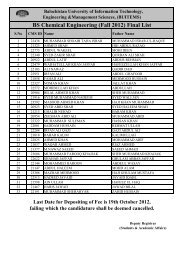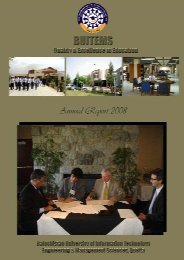BUITEMS
Research Journal - buitems
Research Journal - buitems
- No tags were found...
You also want an ePaper? Increase the reach of your titles
YUMPU automatically turns print PDFs into web optimized ePapers that Google loves.
<strong>BUITEMS</strong><br />
Quality & Excellence in Education<br />
Rational Design of Retaining Walls<br />
Indicators of construction of retaining walls with RVF and EVF are shown in Table. 5.1.<br />
Table 5.1 The laboriousness of the construction of retaining walls in the man-hours per 1m 2 of wall<br />
work RVF from inventory formwork Styrofoam EVF<br />
Reinforcement Installation 0,95<br />
Void Former Installation 0,75 0,34<br />
Formwork Installation 0,5<br />
Concreting 2,3<br />
Void Former Removing 0,5 –<br />
Dismantling of formwork 0,32<br />
Total 5,32 4,41<br />
Approximate cost of construction of retaining walls are shown in Table 5.2. To compare the cost characteristics of<br />
technology of RVF and EVF we assumed that the cost of concrete delivery=106UAH/m 3 ,<br />
reinforcement=1000UAH/t, polystyrene =400UAH/m 3 , 1 man-hour = 12UAH, crane rent=63UAH/hr, formwork<br />
rentals 0.5=UAH/m 2 day.<br />
Table 5.2 Approximate cost of construction of retaining walls UAH per 1m 2 of wall (not including consignment expenses<br />
and value-added tax)<br />
Work RVF from inventory formwork Styrofoam EVF<br />
Concret<br />
0,52х106=55<br />
Reinforcement<br />
0,049х1000=49<br />
Styrofoam – 0,6х40=24<br />
Construction of wall according to<br />
table 5.1<br />
5,32х12=64<br />
4,41х12=53<br />
Сrane Rental<br />
0,16х63=10<br />
Formwork Rental 4,9х5х0,5=12 2х5х0,5=5<br />
Total 190 196<br />
Analysis of data in Table 5.2 shows that walls with EVF are costly compared with wall with RVF<br />
about 194 -190 ·1 00% = 2.1% , however, the laboriousness of construction of second wall exceeds the<br />
190<br />
laboriousness of construction of first. Just heat and sound insulating characteristics of the first several times higher<br />
than second, due to the presence of polystyrene void formers. The economic feasibility of EVF increases with<br />
decrease in volume of internal voids, and consequently, the consumption of polystyrene.<br />
Thus, for optimal (complex geometry) structures of retaining walls, for the vast majority of cases it is advisable to<br />
use EVF made from effective materials such as styrofoam.<br />
CONCLUSION<br />
Consideration of strain of "retaining wall - soil" together, increases the correctness of the models, by providing the<br />
features of resistance this biagregata. Representation of similar structure (retaining wall) in the form of finite<br />
element determines the possibility of direct and indirect problems of design. In turn, the dirct (optimization)<br />
approach allows us to create a structure with rational and high competitive characteristics.<br />
REFERENCES<br />
• Klein, G. K. (1964). Analysis of Retaining Walls. Publ. High School, Moscow, p1964 to p1969.<br />
• Shmukler V. S., Klimov U. A., Burak N. P., Lightweight Frame System. Kharkov, Golden Pages, 2008,<br />
336p.<br />
• Vasilkov G. V., Evolutionary Theory of Life Cycle of Mechanical Systems: Theory of structures, publ.<br />
LKI, Moscow: 2008, 320.<br />
• Sorochan E. A., Trofimenkov U.G., Soil, Foundation and Underground Structures. Stroiizdat, Moscow,<br />
1985, 408p.<br />
• Shmukler V. S., About One Possibility of Compromise-Criterion Construction in Structure Parameter<br />
Rationalization Task Dundee, Scotland, 2008<br />
• Shmukler V. S., Evolutionist approach in rationalization of building structures. /ISEC-03 Third<br />
Internetional structural Engineering and construction Conference, Shunan, Japan, 2005.<br />
121
















